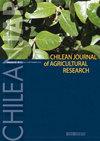乙烯利对盐胁迫下苦荞生理特性及基因表达的影响
IF 1.7
4区 农林科学
Q2 Agricultural and Biological Sciences
引用次数: 1
摘要
耐盐“川桥1号”和耐盐“川桥2号”苦麦被用作材料。在150mM NaCl胁迫下,用不同浓度的乙烯利(ETH)研究了乙烯利对苦荞麦盐胁迫下生理特性的影响。乙烯利处理能提高盐胁迫下两个品种的种子发芽率,对盐敏感品种乙烯利处理效果较好。乙烯利处理可以改善盐胁迫下苦荞麦幼苗的生理特性,耐盐和耐盐品种的ETH根处理浓度分别为1.0和1.5mM,喷洒ETH的浓度分别为0.4和0.6mM。盐胁迫条件下施用ETH对苦麦生理特性的改善效果优于根处理。耐盐基因FtNHX1在24小时达到最大表达水平,在ETH根处理下,耐盐和盐敏品种的表达量分别比盐胁迫增加了277.77%和251.17%,而在ETH喷雾处理下,在耐盐和耐盐品种中,表达量分别与盐胁迫相比增加了232.39%和190.91%。耐盐基因FtSOS1在12h达到最大表达水平,在ETH根处理下,耐盐和盐敏品种的表达水平比盐胁迫提高了60.94%和98.75%,而在ETH喷雾处理下,在耐盐和耐盐品种中,表达水平比盐水胁迫提高了35.98%和67.63%。关键词:Ethephon,生理特性,盐胁迫,苦荞麦。本文章由计算机程序翻译,如有差异,请以英文原文为准。
Effects of ethephon on physiological characteristics and gene expression of Tartary buckwheat under salt stress
Salt-tolerant ‘Chuanqiao No.1’ and salt-sensitive ‘Chuanqiao No.2’ Tartary buckwheat (Fagopyrum tataricum (L.) Gaertn.) were used as materials. Effects of ethephon on physiological characteristics of Tartary buckwheat under salt stress were studied by different concentrations of ethephon (ETH) under 150 mM NaCl stress. Ethephon treatment could improve seed germination rate of both varieties under salt stress, and the effect of ethephon treatment on salt-sensitive variety was better. Ethephon treatment could improve physiological characteristics of Tartary buckwheat seedlings under salt stress, and appropriate concentrations of ETH root treatment in salt-tolerant and salt-sensitive variety were 1.0 and 1.5 mM, and for ETH spraying were 0.4 and 0.6 mM. The effect of ETH spraying on improving physiological characteristics of Tartary buckwheat under salt stress was better than that of ETH root treatment. Salt tolerance gene FtNHX1 reached its maximum expression level at 24 h, which was increased by 277.77% and 251.17% in salt-tolerant and salt-sensitive variety compared with salt stress under ETH root treatment, while under ETH spraying treatment, which was increased by 232.39% and 190.91% in salt-tolerant and salt-sensitive variety compared with salt stress. Salt tolerance gene FtSOS1 reached its maximum expression levels at 12 h, which was increased by 60.94% and 98.75% in salt-tolerant and saltsensitive variety compared with salt stress under ETH root treatment, while under ETH spraying treatment, which was increased by 35.98% and 67.63% in salt-tolerant and salt-sensitive variety compared with salt stress. Key word: Ethephon, physiological characteristics, salt stress, Tartary buckwheat.
求助全文
通过发布文献求助,成功后即可免费获取论文全文。
去求助
来源期刊
CiteScore
3.00
自引率
11.80%
发文量
60
审稿时长
6 months
期刊介绍:
ChileanJAR publishes original Research Articles, Scientific Notes and Reviews of agriculture, multidisciplinary and agronomy: plant production, plant protection, genetic resources and biotechnology, water management, soil sciences, environment, agricultural economics, and animal production (focused in ruminant feeding). The editorial process is a double-blind peer reviewing, Editorial Office checks format, composition, and completeness, which is a requirement to continue the editorial process. Editorial Committee and Reviewers evaluate relevance and scientific merit of manuscript.

 求助内容:
求助内容: 应助结果提醒方式:
应助结果提醒方式:


